Early Spring AGS Show, 2012
We gardeners are, like fishermen, often accused of exaggeration. This season has, however, undoubtedly proved a difficult one, so far, for alpine plants destined for the show bench. I cannot recall an Early Spring Show when no Farrer Medal was awarded but this indeed happened at Harlow.
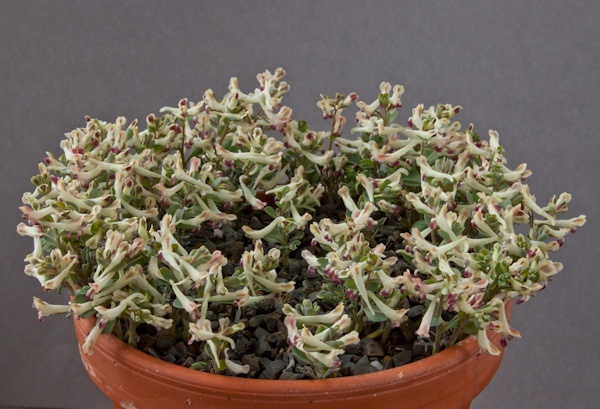
Among a number of quality Corydalis, C. darwasica, shown by Bob and Rannveig Wallis, stood out for its compact and floriferous nature. This was awarded Best in Show and a Certificate of Merit and, indeed, it was quietly attractive. The blue- grey foliage subtended elegant creamy white ice-cream cornets, tipped outside with lines of grey-green and with lilac-maroon inside the open lips.
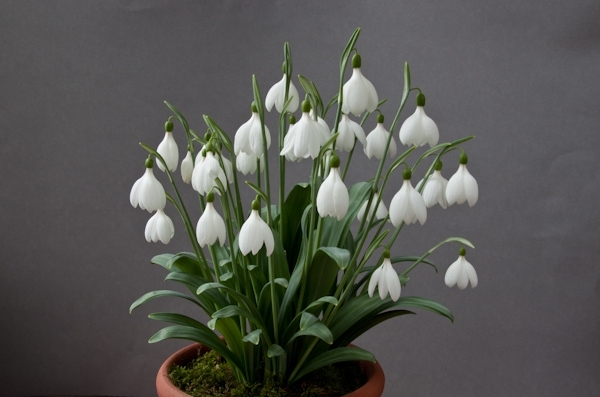
Creating much interest was a potful of Galanthus ‘E.A. Bowles’. Speculation as to its value on e-Bay was rife but this was tempered with admiration for the almost G. ‘Augustus’-like texture of the pristine white globular flowers. This plant, shown by Monksilver Nursery, was given an Award of Merit by the Joint Rock Garden Plant Committee later in the day.
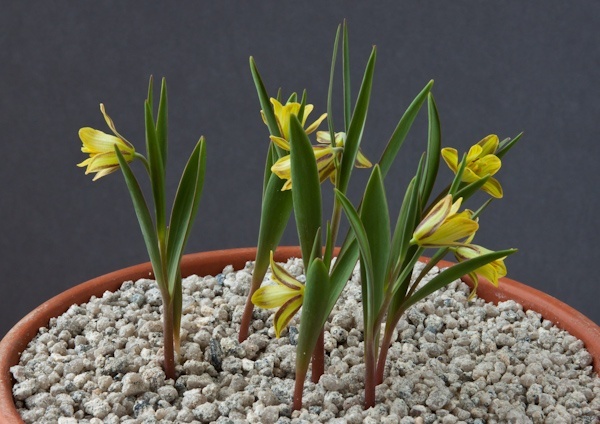
Ian Robertson’s dainty pot of Fritillaria kittaniae provided quite a contrast. It is an elegant little Frit of pale lemon-yellow, the outer tepals delicately edged with palest cinnamon accentuating their gentle outward curve. The plants exhibited were grown from seed from south-west Turkey, probably sown in 2002. This form was selected and increased initially by splitting the bulbs and, for the last two years, has begun to produce offsets. It is grown in a standard mix plus some sand and Seramis in a lattice pot plunged in a sand bed.
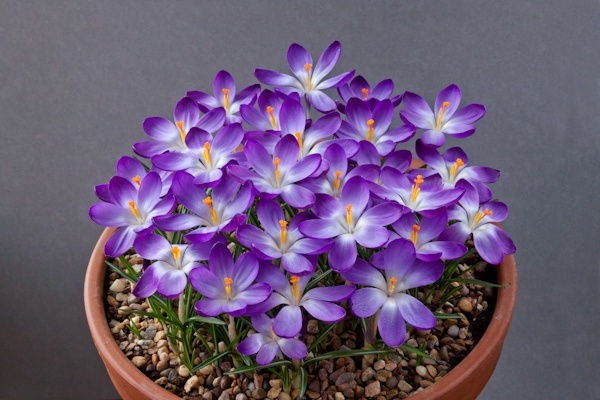
The Crocus Spoon was awarded to a glowingly vibrant potful of C. tommasinianus ‘Ruby Giant’ shown by Peter Hurren.
A single stem of Iris kuschakewiczii with two open flowers, shown by Ruth and Alan Jones, was eye-catchingly delicate in the class for plants rare in cultivation. According to the Iris expert Tony Hall, it is one of the Tien Shan Junos and one of the most easterly geographically. They are compact, almost stemless plants with markedly wiry roots, flowers with a dissected or toothed crest and a more or less parallel-sided haft to their falls so they form a distinct little group, but related to another Tien Shan group comprised of Iris graeberiana, I. albomarginata and I. willmottiana. I. kuschakwiczii is a species of fairly arid habitats in foothills at 800-1,500m altitude.
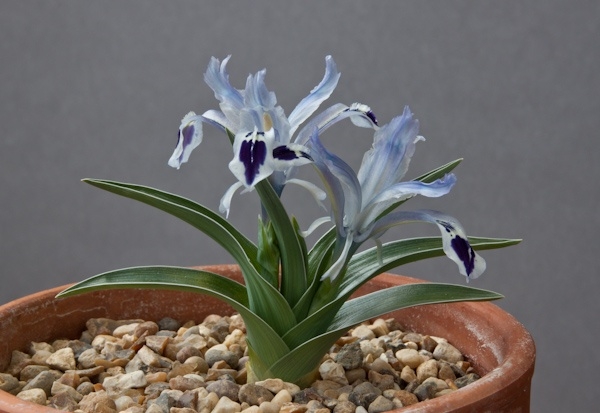
It is not easy to maintain for long and does not form offsets readily but will produce good seeds if pollinated carefully. Flowering takes about 5-7 years from seed. The plant exhibited was a good representative of the species in both flower and habit. The plant had typical silvery edged Juno leaves bearing flowers with standards of a watered-silk blue background underlined with a lemon flash. The falls echoed the pale blue but with almost French-blue blotches under the palest lemon beard – an altogether charming plant.
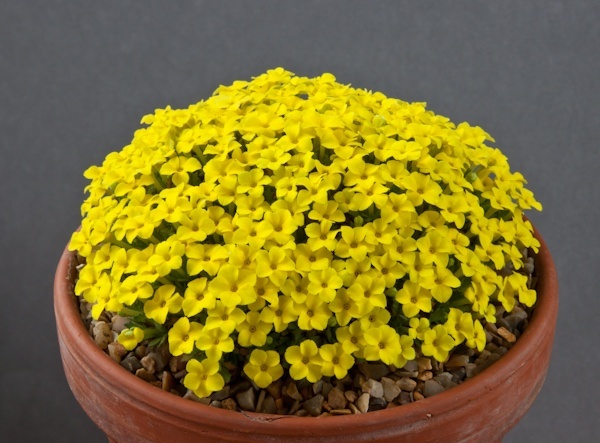
As ever, Paul and Gill Ranson brought an excellent range of their favourite Dionysias. One of the more recent introductions was the Certificate of Merit-winning D. termeana: true golden yellow florets making a dome over soft green (barely visible) slightly dentate leaves. This plant had been raised by Nigel Fuller, grown in a mix of approximately 60% 1mm grit, 20% John Innes No. 2, 10% Seramis and 10% perlite. It resides permanently in the alpine house in a 6-inch sand plunge through which all watering is given. The exception to this is very occasional direct watering to apply a low strength high potash, low nitrogen feed. This clone is from the JLMS expedition but several other collections exist.
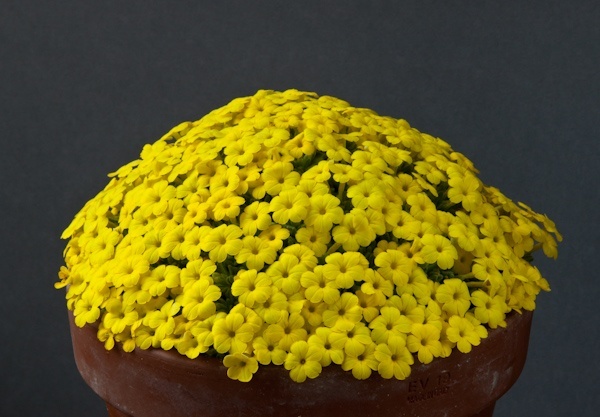
Bob Fenwick showed an excellent form of Dionysia aretioides. These days it is a species which seems to have fallen out of favour, as so many exciting introductions from the wild and cultivated hybrids catch the specialists’ eyes.
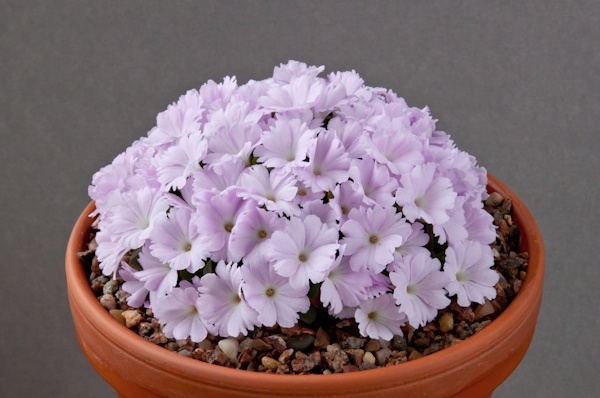
Remaining with Primulaceae – and good old varieties – Don Peace showed an almost perfect small pan of Primula allionii ‘Anna Griffith’: the neatest icing sugar-pink dome of serrated petals with barely a leaf showing.
